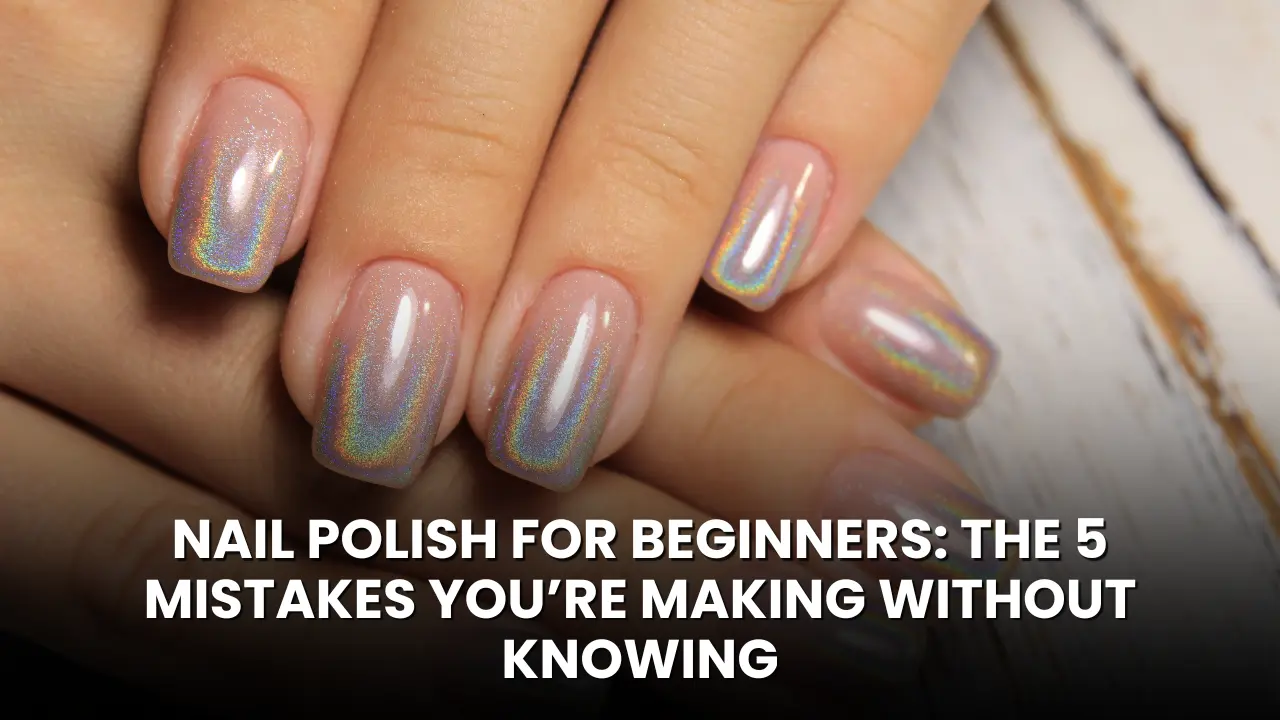Nail Polish for Beginners: The 5 Mistakes You’re Making Without Knowing

For Distributors & Wholesalers
We welcome partnerships with distributors and wholesalers who wish to expand their business with a trusted and growing cosmetic brand.
Why Partner with Avlon International?
- Wide range of cosmetics: Nail polish, mascara, kajal, eyeliner, liquid lipstick, lipstick & more.
- Premium quality with competitive wholesale pricing.
- Attractive margins and fast-moving products.
- Assured support with marketing materials & promotional offers.
- PAN India shipping with secure packaging.
📦 Minimum Order Quantity (MOQ): 1 master carton (72 trays)
💰 Special Discounts: Available for bulk & long-term partners.
🚚 Dispatch & Delivery: PAN India in around 10-15 days.
📞 Contact Us:
Phone / WhatsApp: +91 88105 67775
Email: contactus@avloninternational.com
Website: www.avloninternational.com
Are you staring at your freshly painted nails wondering why they look like abstract art gone wrong? Don’t worry – you’re not alone in this colorful catastrophe! Every nail polish enthusiast has been there, standing in their bathroom at 11 PM, wondering how something that looks so effortless on social media can turn into a disaster movie when you try it at home.
The truth is, nail polish application is like learning to ride a bike – except the bike is made of liquid, dries in minutes, and everyone can see your mistakes. But here’s the good news: most nail polish failures aren’t due to lack of artistic talent or steady hands. They’re usually the result of five common mistakes that beginners make without even realizing it.
Whether you’re a complete novice who just discovered that base coat isn’t just a marketing ploy, or someone who’s been painting their nails for years but still can’t figure out why they chip faster than a stale cookie, this guide will transform your nail game from “oops” to “oh wow!”
The Great Nail Polish Mystery: Why Do Beginners Struggle?
Before we dive into the mistakes, let’s talk about why nail polish seems to have a personal vendetta against beginners. Unlike other beauty routines where you can easily fix mistakes, nail polish is unforgiving. One wrong move and you’re either starting over or walking around with what looks like a toddler’s art project on your fingertips.
The nail polish industry has evolved tremendously, with brands like Avlon International leading the charge in creating formulas that are more user-friendly than ever before. Yet, even with these improvements, beginners still find themselves making the same fundamental errors that turn a simple manicure into a three-hour ordeal.
The secret isn’t in having perfect hands or professional tools – it’s in understanding what you’re doing wrong and how to fix it. Most people learn nail polish application through trial and error, which is like learning to cook by randomly throwing ingredients in a pot and hoping for the best. Sure, you might occasionally create something edible, but more often than not, you’ll end up ordering takeout.
Mistake #1: Skipping the Foundation Work (And No, We Don’t Mean Makeup)
Let’s start with the mistake that’s so fundamental, it’s like trying to build a house without laying the foundation first. We’re talking about nail preparation – the boring, unglamorous step that everyone wants to skip but absolutely shouldn’t.
Picture this: You’re excited about your new nail polish color, you’ve got your favorite TV show queued up, and you’re ready to create some nail art magic. So you grab the bottle and start painting directly onto your natural nails. Twenty minutes later, you’re wondering why your beautiful manicure looks like it was applied during an earthquake.
Here’s what’s happening: your natural nails have oils, moisture, and microscopic debris that prevent polish from adhering properly. It’s like trying to put a sticker on a wet surface – it might stick temporarily, but it’s not going to last.
The proper preparation process might seem tedious, but it’s the difference between a manicure that lasts two days and one that lasts two weeks. Start by removing any old polish completely – and we mean completely. Those tiny bits of color hiding around your cuticles aren’t “vintage charm,” they’re sabotage waiting to happen.
Next, wash your hands thoroughly and push back your cuticles. This isn’t just about aesthetics; it’s about creating a clean canvas. Think of your nails as a artist’s canvas – you wouldn’t paint on a dirty, textured surface and expect professional results.
File your nails in one direction (not back and forth like you’re starting a fire) and buff away any ridges. Your nails should feel smooth when you run your finger across them. If they feel bumpy, your polish will look bumpy too.
The final step that most beginners skip is using a dehydrator or simply wiping nails with rubbing alcohol. This removes any remaining oils and ensures your base coat has something to grip onto. Avlon International’s base coat formulations are designed to work optimally on properly prepared nails, creating a strong foundation that extends wear time significantly.
Mistake #2: The “More is Better” Mentality
If you think applying thick coats of nail polish will give you better coverage and save time, you’re about to learn why this logic is flawed. This mistake is so common that it deserves its own support group: “Thick Coaters Anonymous.”
The thick coat mistake usually happens when beginners see streaky coverage after their first coat and think, “I’ll just put on more polish to cover it up.” It’s like trying to fix a wobbly table by adding more weight to it – you’re actually making the problem worse.
Here’s the science behind why thick coats are nail polish kryptonite: nail polish needs to dry evenly from the outside in. When you apply a thick coat, the outer layer forms a skin while the inner layer remains wet. This creates a situation where your nails look dry on the surface but are actually still liquid underneath. The result? Dents, smudges, and a manicure that takes forever to fully cure.
Thick coats also lead to another phenomenon that beginners find mystifying: the dreaded bubble effect. When you apply polish too heavily, you trap air bubbles that create a bumpy, uneven surface. It’s like trying to paint a wall with peanut butter – technically possible, but the results aren’t pretty.
The correct approach is to apply thin, even coats and build up coverage gradually. Think of it like spray-tanning – multiple light coats give you better, more natural-looking results than one heavy application that leaves you looking like an orange traffic cone.
Start with a base coat, then apply your first color coat thinly. Don’t worry if it looks streaky or uneven – that’s normal and expected. The second coat will even out the coverage, and if needed, a third thin coat will give you that salon-perfect finish.
Avlon International’s polish formulas are specifically designed to work with this thin-coat method, providing excellent coverage without requiring heavy application. The key is patience – something that’s in short supply when you’re excited about your new nail color, but absolutely essential for professional-looking results.
Mistake #3: Ignoring Your Cuticles (The Unsung Heroes of Nail Care)
Cuticles are like the supporting actors in a movie – they might not be the star, but they can make or break the entire production. Yet beginners often treat them like unwanted extras, ignoring them completely or, worse, attacking them with inappropriate tools.
The cuticle mistake manifests in two ways: either completely ignoring them or going medieval on them with sharp instruments. Both approaches lead to problems that can sabotage even the most carefully applied polish.
When you ignore your cuticles, they become dry, overgrown, and start to peel. This creates an uneven surface around your nail bed that makes polish application difficult and unprofessional-looking. It’s like trying to paint a picture frame while the frame is still covered in masking tape – the end result will always look unfinished.
On the flip side, some beginners think cuticle care means aggressive cutting and trimming. This approach can lead to infection, bleeding, and damaged nail beds that take weeks to heal. It’s like trying to landscape your yard with a chainsaw – technically you’re removing unwanted growth, but you’re probably causing more damage than necessary.
The correct approach to cuticle care is gentle and consistent. Start by soaking your hands in warm water for a few minutes to soften the cuticles. Then, using a cuticle pusher or even just a washcloth, gently push back the cuticles to reveal more of your nail bed.
If you have excess cuticle skin, use cuticle scissors or nippers to carefully trim only the loose, dead skin. The key word here is “carefully” – you want to remove only what’s necessary, not perform surgery.
After pushing back your cuticles, apply cuticle oil or moisturizer to keep them healthy and prevent them from overgrowing quickly. This step is often overlooked, but it’s crucial for maintaining healthy nails and making future manicures easier.
When you properly care for your cuticles, you create a clean, professional-looking nail bed that showcases your polish beautifully. The difference is immediately noticeable – it’s like the difference between a professionally framed photograph and one that’s just tacked to the wall.
Mistake #4: The Waiting Game (Or Lack Thereof)
Patience is a virtue, especially when it comes to nail polish. Unfortunately, it’s a virtue that most beginners haven’t developed yet. The “rushing between coats” mistake is responsible for more nail polish disasters than any other single factor.
Here’s the scenario: You apply your base coat, wait about thirty seconds (maybe a full minute if you’re feeling generous), then apply your first color coat. Another minute passes, and you’re on to the second color coat. Top coat goes on immediately after, and you’re done! Except you’re not done – you’re just beginning a journey into smudge city.
The problem with rushing is that nail polish needs time to set properly between coats. When you apply the next coat before the previous one has had adequate drying time, you create layers that don’t bond properly. It’s like trying to build a sandwich with wet bread – everything just slides around and becomes a mess.
But here’s where it gets tricky: nail polish can feel dry to the touch while still being wet underneath. This surface drying is what fools beginners into thinking they’re ready for the next coat. Touch-dry is not the same as ready-for-the-next-coat dry.
The general rule is to wait at least two to three minutes between coats, but this can vary depending on the formula, thickness of application, and environmental conditions. In humid conditions, you might need to wait even longer. It’s like baking a cake – the recipe gives you a guideline, but you need to adjust based on your specific conditions.
A good test for readiness is the “gentle touch test.” Lightly touch your nail with the pad of your finger (not the tip). If the polish feels tacky or leaves an impression, it’s not ready for the next coat. If it feels smooth and doesn’t show any mark from your touch, you’re good to go.
Avlon International’s quick-dry formulas are designed to reduce waiting time between coats, but even these advanced formulations require some patience. The investment in waiting time pays off with a manicure that looks professional and lasts significantly longer.
Mistake #5: The Flood Gates Are Open (Literally)
The final mistake that trips up beginners is flooding – getting polish on the skin around your nails instead of just on the nail itself. This mistake makes even the most expensive polish look like a amateur hour production.
Flooding happens for several reasons, but the most common is using too much polish on the brush and not having proper brush control. When you dip the brush in the bottle, it picks up way more polish than you actually need. If you don’t remove the excess, it’s like trying to paint with a loaded paintbrush – you’re going to make a mess.
The correct technique is to dip the brush into the polish, then wipe one side of the brush on the neck of the bottle. This removes excess polish and gives you better control over application. You want just enough polish on the brush to cover the nail without it dripping or flowing uncontrollably.
Another cause of flooding is starting too close to the cuticle. Beginners often think they need to get the polish right up to the cuticle line for complete coverage. While this is the eventual goal, it requires a level of precision that takes practice to develop.
A better approach for beginners is to start with a small bead of polish in the center of the nail, about 1/8 inch away from the cuticle. Then, gently push this bead toward the cuticle line without actually touching it. This technique gives you better control and reduces the risk of flooding.
When you do get polish on your skin (and you will – it happens to everyone), don’t panic. Let it dry completely, then use a small brush dipped in nail polish remover to clean up the excess. Trying to clean up wet polish usually just spreads it around and makes the problem worse.
The key to avoiding flooding is practice and patience. Start with lighter colors, which are more forgiving of mistakes, and gradually work your way up to darker, more dramatic shades as your technique improves.
The Psychology of Nail Polish Mistakes
Understanding why these mistakes happen can help you avoid them in the future. Most nail polish errors stem from impatience, unrealistic expectations, and the desire to skip steps. In our fast-paced world, we want everything to be quick and easy, but nail polish is one area where shortcuts almost always lead to longer.
Think about it: if you rush through the process and end up with a subpar manicure, you’ll either have to live with it (which affects your confidence) or start over (which takes even more time). Taking the time to do it right the first time is actually the more efficient approach.
There’s also a psychological component to nail polish application that beginners often underestimate. Your mental state affects your hand steadiness, patience level, and attention to detail. Trying to do your nails when you’re stressed, tired, or in a hurry is like trying to thread a needle during an earthquake – technically possible, but not recommended.
Creating Your Personal Nail Polish Routine
Now that you know what not to do, let’s talk about creating a routine that works for you. The key is to find a balance between thoroughness and practicality – you want professional results without turning nail painting into a day-long event.
Start by setting aside adequate time for your manicure. A basic manicure should take about 45 minutes to an hour, including drying time. This might seem like a lot, but remember that rushing leads to mistakes, which leads to starting over, which takes even more time.
Create a dedicated space for your nail care routine. This doesn’t have to be elaborate – a well-lit table with all your supplies organized and within reach is sufficient. Good lighting is crucial because you can’t fix mistakes you can’t see.
Invest in quality products, particularly base coat, top coat, and polish remover. These aren’t areas where you want to cut corners. Avlon International offers comprehensive nail care systems that work together to deliver professional results at home.
Develop a ritual around your manicure routine. Put on a favorite movie, listen to music, or use the time for meditation. When you approach nail care as a relaxing, enjoyable activity rather than a chore, you’re more likely to take your time and do it properly.
The Long-Term Benefits of Proper Technique
Learning proper nail polish application techniques pays dividends beyond just having pretty nails. When you master these basics, you save time in the long run because your manicures last longer and look better. You also save money by not having to constantly touch up or redo your nails.
There’s also a confidence boost that comes from having well-maintained nails. When your nails look good, you feel more put-together and professional. This subtle confidence boost can affect how you carry yourself and how others perceive you.
Finally, proper nail care is actually good for your nail health. When you follow correct preparation and application techniques, you’re less likely to damage your natural nails, and you’re more likely to notice and address any nail health issues early.
Conclusion: Your Journey to Nail Polish Mastery
Mastering nail polish application is like learning any other skill – it takes time, practice, and patience. The five mistakes we’ve covered are incredibly common, so don’t feel bad if you recognize yourself in any of them. Every expert was once a beginner who made these same errors.
The key is to focus on one aspect at a time rather than trying to perfect everything simultaneously. Start with proper preparation, then work on your coating technique, then focus on cuticle care, and so on. Each improvement builds on the previous one, creating a foundation for beautiful, long-lasting manicures.
Remember, the goal isn’t perfection on your first try – it’s progress. Each manicure is an opportunity to practice and improve. With quality products and proper techniques, you’ll soon be creating salon-worthy manicures in the comfort of your own home.
Your nails are a canvas for self-expression, and now you have the knowledge to make that canvas beautiful. So grab your favorite polish, take a deep breath, and remember – even if you make mistakes, nail polish remover exists for a reason. Happy painting!
📌 Disclaimer
The information provided in this blog is for general informational purposes only. While Avlon International makes every effort to ensure the accuracy and reliability of the information shared, we make no representations or warranties of any kind, express or implied, about the completeness, accuracy, reliability, suitability, or availability with respect to the content.
Any reliance you place on such information is therefore strictly at your own risk. Avlon International shall not be held liable for any loss, damage, or inconvenience arising in connection with the use of this blog or its content.
For official details regarding our products, distributor policies, or business partnerships, please contact us directly at WhatsApp +91 88105 67775.




